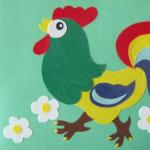Africa's hottest beauty pageant that makes babies. Namibia
The Himba have almost no water at all: every drop that can be obtained will be carefully preserved and drunk. To also wash with water is unimaginable here.
The Himba have been helped to survive since time immemorial by a magical ointment, to which they owe their now famous red skin tone: a mixture of butter churned from the milk of their skinny cows, various plant elixirs, as well as bright red volcanic pumice “okra” ground into the finest powder. Himba women apply this mixture to their entire body and hair several times a day.
The ointment helps maintain the required level of hygiene, protects against sunburn and insect bites.
Surprisingly, Himba women have absolutely perfect skin. And they smell quite pleasant - just a little bit of melted butter...
The same super cream serves as the basis for a traditional hairstyle. Long "dreadlocks", however, are grown approximately twice as long with someone else's hair: usually male, most often respectfully accepted from the father of the family.
By the way, every resident of a Himba village has, in addition to the one received at birth, also a “European” name.
Children receive it when they study in mobile free schools organized by the state: almost everyone goes to study, so almost everyone knows how to count, can write their name, say a few English words and phrases (first of all, English numbers come in handy - especially when it comes time to bargain ).
After the first two or three classes, very few continue to study. Only a rich family can afford to send a child to the city, to a “big” school: education, housing, clothing, food in the city cost an average of seven cows a year. But sometimes it happens.
From there, from the city, comes the most terrible problem of the Himba: AIDS. In Namibia, almost 20 percent of the population is infected with AIDS, and the Himba have a purely philosophical attitude towards the danger of becoming infected: God gave, God takes away.
Of course, they are not talking about any kind of prevention. But if you’re lucky and don’t get infected with AIDS in childhood or youth, the Himba live for quite a long time: often longer than 70 years, and sometimes live up to 100. However, old people are not visible in the village: either in distant pastures, with livestock, or in huts where tourists are not allowed.
An ideal starting point for a trip to the Himba settlements is the town of Opuwo. Already here, by the way, you can meet representatives of the Himba. Don't be surprised if you see one of these gorgeous ladies in the supermarket.
It is better to go directly to the Himba village with a local guide. He will be able to negotiate with the tribal leader about visiting the “kraal” (the traditional home of the Himba) and he will talk about the life and culture of the Himba.
The Himba tribe lives in northern Namibia. The people of this tribe are very beautiful. They are far from civilization.
The only thing they need is combs, hairpins, and bags. They carry children and store small things in them.
There is practically no water in the places where the tribe lives. For this reason, villagers do not wash. They use a special ointment to protect them from the sun and insects. It consists of fine volcanic lava, fat and herbs. They are coated with this cream from head to toe. It would seem that due to such minimal care, their skin should be covered with various growths. However, their faces are absolutely clean and their skin is smooth.

The most important decoration of the Himba are their hairstyles. Unmarried girls braid two braids that fall over their faces. Married ladies braid a lot of dreadlocks and decorate them with all kinds of objects.

Boys living in the tribe are considered adults from the age of 12. The Himba's initiation into adulthood goes like this: boys' lower teeth are pulled out and their gums are cauterized. A man can have 2-3 wives, and girls are married off at the age of 14.

It is also worth noting that the murder of spouses is considered a personal matter. No one is convicted of murder. But if a husband kills his wife, then he must pay her parents compensation of 45 cows. Marital fidelity also does not exist for the Himba. It is customary in the tribe to exchange spouses. 
In the north of the country, near the border with Angola, in the province of Kaokoland, lives the amazing Himba tribe. Recently, they began to occasionally allow people from the “outside” world to visit them, and after several reports about them that appeared in the world’s largest magazines and on Discovery, many people wanted to visit their villages. One thing attracts guests: the amazing beauty and special, strange grace of the Himba woman.


2. In fact, this is almost impossible to find in modern Africa: a completely primitive way of life remained natural for these people, not at all ostentatious. These are not the East African Maasai, who for many decades have practically lived on extortions from passing tourists as their main livelihood, and rush headlong to change into “primitive” clothes as soon as they see the sweet dust from under the wheels of a tourist bus on the horizon. And the Himba are like that in reality: they lead a semi-sedentary, semi-nomadic tribal existence in zones of almost completely lifeless desert, in conditions of severe water shortage. Not because they “failed to break through to civilization,” but because even today they prefer to live this way and do not need almost anything that they do not have and never had. The Himba people are truly as a visitor might see them. And our first meeting took place on the eve of the planned visit to the tribal village: in the tiny town of Opuwo, the capital of Kaokoland, we met one lady who, as if nothing had happened, showed up at the supermarket to do some shopping.

3. The Himba live by raising cattle. In essence, the only thing they have are skinny, but very unpretentious and tenacious cows of a special breed, ready, almost like camels, to go without water for weeks. By selling these cattle on rare and special occasions, the Himbas earn some money. Well, frequent guests will sometimes buy some simple souvenirs and crafts. And then they come to the city - for cornmeal, sugar, some delicacies for the children. They don't need any clothes, other than plastic flip-flops, which will come in handy in this rocky desert. They do not use any utensils - except for gourd vessels, sometimes replaced with large plastic drinking water bottles. And in general, it seems that they do not suffer at all from the lack of all these attributes of civilization.

4. There could be dozens of new Naomi Campbells out of Himba girls. And where do modeling agencies look?..

5. There are only two items that, as we noticed, have become essential items for them and are widely used in everyday life. Firstly, there are various kinds of combs and combs with which Himba women spend hours combing the special kind of “pom-poms” that crown their whimsical and complexly structured hairstyles.

6. And secondly, multi-colored cellophane rustling bags from the supermarket, with which they are ready to decorate themselves and their amazing toilets, and store all their belongings in them, and tie children to their belts, and also use them in a thousand ways, sometimes quite unexpected...

7. Here, pay attention to the elegant bow in the hair, for example...
8. The Himba have almost no water at all: every drop that can be obtained will be carefully preserved and drunk. To also wash with water is unimaginable here. The Himba have been helped to survive since time immemorial by a magical ointment, to which they owe their now famous red skin tone: a mixture of butter churned from the milk of their skinny cows, various plant elixirs, as well as bright red volcanic pumice “okra” ground into the finest powder. Himba women apply this mixture to their entire body and hair several times a day. The ointment helps maintain the required level of hygiene, protects against sunburn and insect bites. Surprisingly, Himba women have absolutely perfect skin. And they smell quite pleasant - just a little bit of melted butter... The same super cream serves as the basis for a traditional hairstyle. Long "dreadlocks", however, are grown approximately twice as long with someone else's hair: usually male, most often respectfully accepted from the father of the family.

9. We went into one hut, and 15-year-old Maria showed us how fresh ointment is mixed from different ingredients, and how Himba girls use it.


11. By the way, every resident of the Himba village has, in addition to the one received at birth, also a “European” name. Children receive it when they study in mobile free schools organized by the state: almost everyone goes to study, so almost everyone knows how to count, can write their name, say a few English words and phrases (first of all, English numbers come in handy - especially when it comes time to bargain ). After the first two or three classes, very few continue to study. Only a rich family can afford to send a child to the city, to a “big” school: education, housing, clothing, food in the city cost an average of seven cows a year. But sometimes it happens. Here is Sonya (in shorts and a yellow T-shirt), at 19 years old, she has been living in the city for several years. Now she came to visit her sisters and brothers, and took her city friend with her.

12. By the way, the watch on the wrist of Maria, who is already familiar to us, was brought as a gift from the city by one of the following “out-of-the-way” relatives:

13. From there, from the city, comes the most terrible misfortune of the Himba: . In Namibia, almost 20 percent of the population is infected with AIDS, and the Himba have a purely philosophical attitude towards the danger of becoming infected: God gave, God takes away. Of course, they are not talking about any kind of prevention. But if you’re lucky and don’t get infected with AIDS in childhood or youth, the Himbas live quite a long time: often longer than 70 years, and sometimes live up to 100. However, old people are not visible in the village: either in distant pastures, with livestock, or in huts where we are not allowed. But here is the one who undividedly controls the destinies and lives of all the women and men of the clan: the head and father of a huge family inhabiting this entire village. He, if necessary, will communicate with the spirits of ancestors, predict the weather, heal the sick, punish the guilty, and protect the offended. And the hair in women’s hairstyles is his. It seemed to us that he was a sincere, cheerful man.

14. Our guide is just his nephew: several years ago he went to live in the city, changed into a shirt and trousers, and now earns money as a guide, bringing guests to relatives. And this, he told us in confidence, is the “first lady,” the senior wife of the “big boss”:

15. Well, now that we have met everyone, this is the final part of the visit. In order not to offend anyone, you should definitely buy some of the local crafts:

16. However, we also have something to offer in response. Here is the contact of civilizations that took place: Motya instantly found a common language with his peers. The parties quickly began exchanging experience and valuable skills. It turned out, for example, that the younger Himba are very fascinated by Motin’s ability to organize a “shadow theater” with different animals and birds, folding their fingers this way and that...

17. True, it turned out to be not so easy to distinguish boys from girls. Motya, for example, immediately singled out this ten-year-old beauty from the company and considered him a friend until the very end...

18. In general, it’s also not good to abuse hospitality. In gratitude for the warm welcome, we leave gifts prepared in advance. All the same flour, vegetable oil, etc. Well, gifts for children - a big bag of cookies. The elder receives a separate gift: a large loaf of pre-sliced white bread.

19. And, of course, it’s also impossible without a final photo as a keepsake.






